When you're looking for the best drive belts for your John Deere 4230, you want options that guarantee durability and peak performance. The right choices can greatly impact your equipment's efficiency and longevity. For instance, you might consider the John Deere GX22036 Flat Traction Drive Belt, which is known for its robust materials. But that's just one of several strong contenders. Let's explore the top five drive belts that can keep your tractor running smoothly and discuss what factors you should consider before making a decision.
Quick Takeaways
- The John Deere GX22036 Flat Traction Drive Belt offers high durability and performance, suitable for various John Deere models including the 4230.
- The John Deere Covered Deck Belt is made from aramid material, ensuring longevity and exceptional fit for models with 48-inch decks.
- Consider the John Deere GX20305 Deck Drive Belt for its straightforward installation and positive user feedback regarding quality and durability.
- The John Deere Original Equipment Belt #RE28721 features strong materials to prevent stretching, with easy installation and high customer satisfaction ratings.
- Opt for the John Deere OEM Cogged Deck Belt for reliability and performance, preferred by users over aftermarket options for various GX Series models.
John Deere GX22036 Flat Traction Drive Belt for Lawn Tractors
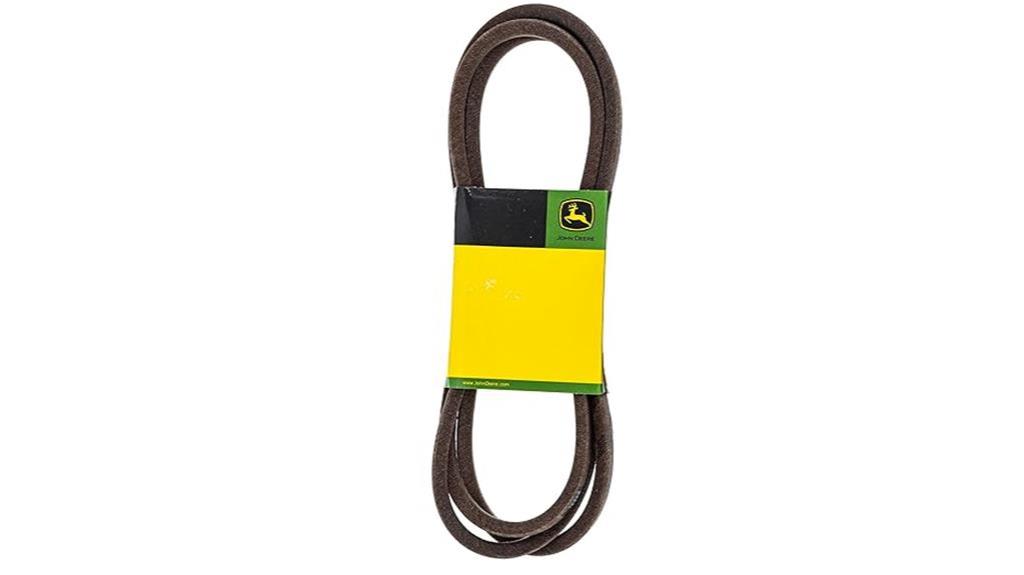
When it comes to maintaining your lawn tractor, the John Deere GX22036 Flat Traction Drive Belt stands out as the best choice for those who prioritize OEM quality and reliability.
I've found that this belt, with dimensions of 1/2" width and 92" length, is built from strong materials that resist stretching and rolling over. It fits multiple John Deere models, including the D100 and LA100, ensuring compatibility for many users.
Customers rave about its quality and appreciate the fast shipping and competitive pricing available on platforms like Amazon.
I've also noticed that, while some might face fit issues with older models, double-checking your mower's specifications can save a lot of hassle.
Overall, I highly recommend this belt for its durability and performance.
Best For: Those seeking a reliable and high-quality OEM replacement belt for their John Deere lawn tractors.
Pros:
- High-quality construction prevents stretching and ensures durability.
- Fits multiple models, providing versatility for John Deere users.
- Fast shipping and competitive pricing make it an appealing choice over local dealers.
Cons:
- Some users may experience fit issues with older models.
- Price may be higher than aftermarket options, which could deter budget-conscious buyers.
- Requires verification of compatibility with specific mower models to avoid issues.
John Deere Covered Deck Belt for D140, D150, D160, L120, L145, L155, LA130, Z255, Z355 (48 Decks)
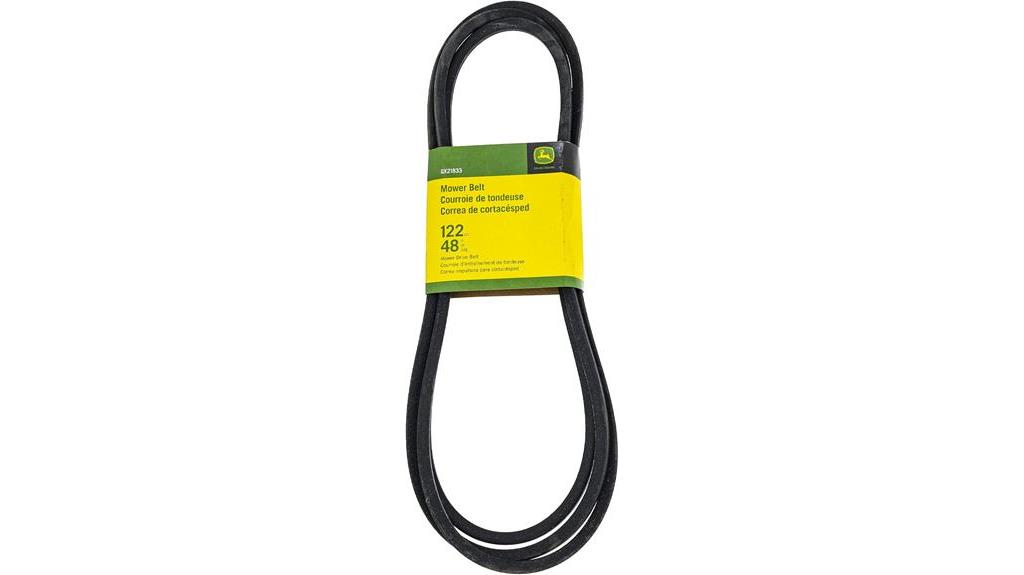
The John Deere Covered Deck Belt, specifically designed for models like the D140, D150, D160, L120, L145, L155, LA130, Z255, and Z355 with 48-inch decks, stands out for its exceptional fit and durability.
Made from high-quality aramid material, it offers an effective length of 141.709 inches and a width of 0.559 inches. Its design guarantees compatibility with various models, providing reliable performance.
Customers rave about its longevity and perfect fit, often noting that it outlasts cheaper alternatives. While some find the price a bit high, the positive feedback, averaging 4.7 stars, reflects its value in maintaining peak lawn care.
Plus, with a 30-day return guarantee, it's a safe investment for your mower.
Best For: Those seeking a durable and reliable replacement belt for their John Deere lawn mowers with 48-inch decks.
Pros:
- High-quality aramid material ensures longevity and durability.
- Perfect fit for a wide range of John Deere models, enhancing performance.
- Positive customer feedback highlights fast delivery and value for money.
Cons:
- Some users consider the price to be on the higher side.
- A few customers noted initial tightness of the belt upon installation.
- Limited availability compared to cheaper alternatives.
John Deere GX20305 Deck Drive Belt
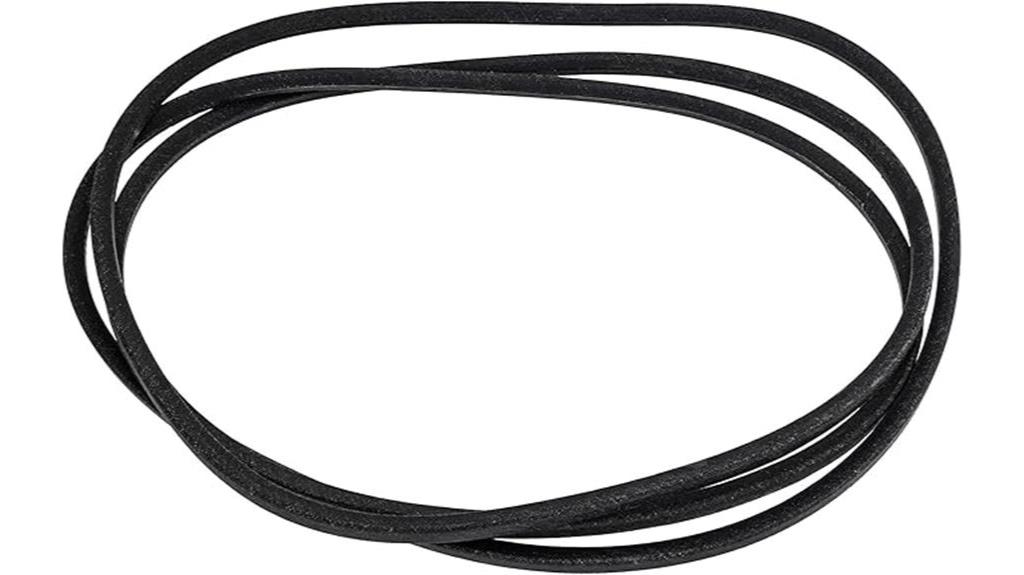
For those seeking reliable performance in their lawn maintenance equipment, the John Deere GX20305 Deck Drive Belt stands out as an exceptional choice.
I've found this belt, compatible with various models like the 1642HS and L130, to be incredibly durable. Weighing just one pound and measuring 16 x 10 x 1 inches, it's built from strong materials that resist stretching and rollover, ensuring longevity.
With a stellar 4.7-star rating from over 500 reviews, it's clear many customers, including myself, appreciate its quality. The installation process is straightforward, but I always double-check for twists afterward.
Overall, I can't recommend this OEM belt enough for anyone looking to enhance their lawn mower's performance. It's worth every penny compared to cheaper alternatives.
Best For: Those seeking a durable and high-quality replacement belt for their John Deere lawn mowers and tractors.
Pros:
- High durability ensures a longer lifespan compared to cheaper alternatives.
- Easy installation process with straightforward instructions.
- Excellent customer satisfaction, reflected in a 4.7-star rating from over 500 reviews.
Cons:
- Potential price variations may lead to higher costs compared to non-OEM options.
- Compatibility issues may arise if the wrong belt length is selected based on tractor serial numbers.
- Limited availability of warranty information could be a concern for some buyers.
John Deere Original Equipment Belt #RE28721
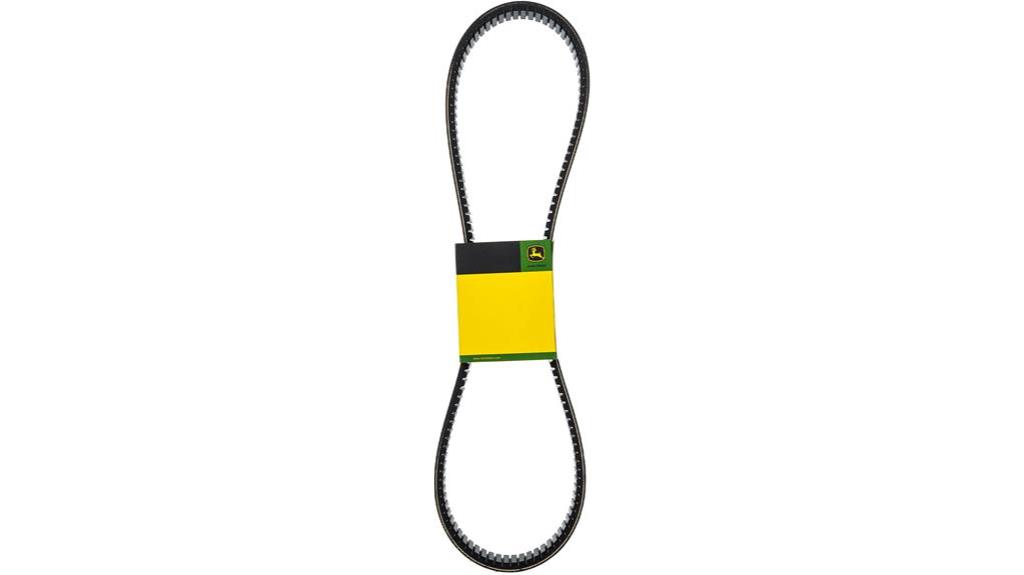
Offering exceptional durability and a perfect fit, the John Deere Original Equipment Belt #RE28721 stands out as an ideal choice for those who own various John Deere models, including Gators and AMTs.
This OEM part measures 56 inches in length and 1 1/4 inches in width, ensuring it fits snugly. Weighing just 1.1 pounds, it's crafted from strong materials designed to prevent stretching and rollover, which I find essential during heavy use.
With an impressive average rating of 4.7 out of 5 stars from 116 reviews, users appreciate its easy installation and high quality. Just remember to double-check the dimensions before purchasing to avoid any size discrepancies.
Overall, this belt is a reliable investment for maintaining your equipment's peak performance.
Best For: those who own John Deere models such as Gators and AMTs looking for a reliable and durable replacement belt.
Pros:
- Pros:
- Easy installation and perfect fit for various John Deere models.
- Made from strong materials to prevent stretching and rollover.
- High average rating of 4.7 out of 5 stars from satisfied customers.
Cons:
- Cons:
- Some users report size discrepancies; verifying dimensions is essential before purchase.
- May not be compatible with non-John Deere equipment.
- Limited warranty information available, requiring inquiry for details.
John Deere OEM Cogged Deck Belt for Lawn Tractors
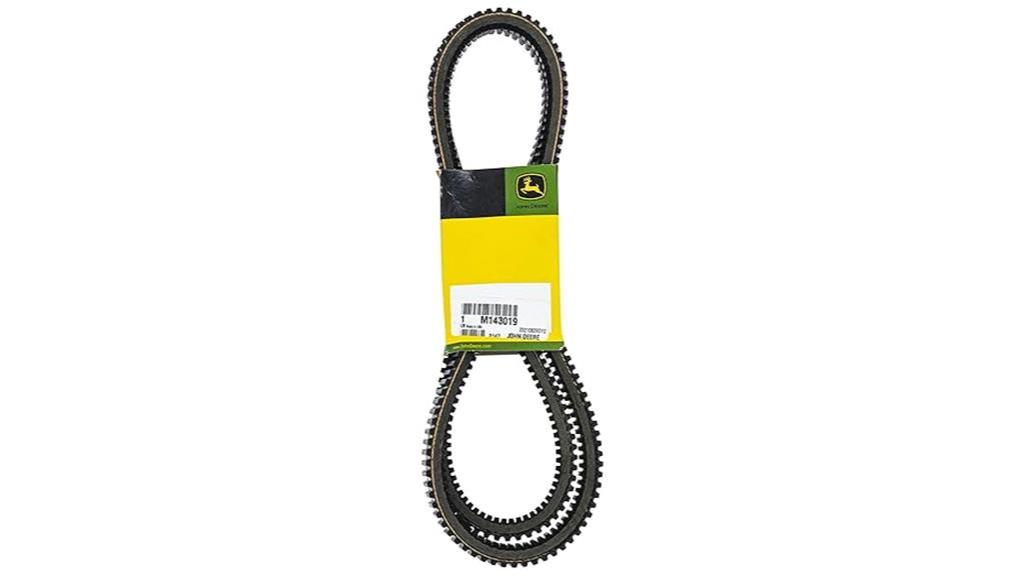
When it comes to maintaining your John Deere lawn tractor, choosing the right drive belt can make all the difference in performance.
I've found that the John Deere OEM Cogged Deck Belt, with part numbers M143019, M118684, and M144677, fits various models like the GX Series and LT170. Made from strong materials, this belt resists stretching and rollover, ensuring durability.
I've noticed that users prefer this OEM belt over off-brand options, often reporting failures with cheaper alternatives. The fit is always perfect, and installation is a breeze. Fast shipping adds to the overall satisfaction.
If you're looking for reliability and peak performance, I highly recommend sticking with the OEM John Deere belts. You won't regret it!
Best For: Those seeking reliable and high-quality replacement belts for John Deere lawn tractors to ensure optimal performance and durability.
Pros:
- High durability: Made from strong materials that resist stretching and rollover.
- Perfect fit: Designed specifically for various John Deere models, ensuring easy installation.
- Positive user feedback: Users report satisfaction and recommend OEM belts over cheaper off-brand options.
Cons:
- Higher cost: OEM belts may be more expensive than off-brand alternatives.
- Limited compatibility: Only compatible with specific John Deere models, requiring users to verify part numbers.
- Availability: May not be as readily available as generic brands in some locations.
Factors to Consider When Choosing Drive Belts for John Deere 4230
When choosing drive belts for your John Deere 4230, there are several important factors to keep in mind.
You'll want to reflect on compatibility with your model, the durability of materials, and the installation process.
Additionally, comparing prices and weighing OEM versus aftermarket options can help you make the best decision for your needs.
Compatibility With Models
Choosing the right drive belt for your John Deere 4230 hinges on verifying compatibility with your specific model. Different models may require different part numbers, so it's vital to check this before making a purchase.
Start by consulting the Original Equipment Owner's Manual, as this document outlines the specifications needed for your tractor.
Keep in mind that the compatibility of a drive belt can also depend on the manufacturing year of your tractor. Design changes over the years may affect the belt's fit and functionality, so double-checking this detail is important.
You can usually find replacement part numbers directly on the tractor, often located near the seat or engine area.
For peak performance and longevity, it's advisable to use OEM (Original Equipment Manufacturer) belts. Non-OEM belts may not fit correctly or could lead to premature wear, which can affect your tractor's efficiency.
Material Durability and Strength
Selecting the right drive belt for your John Deere 4230 means considering the material's durability and strength. The materials used in drive belts greatly affect their performance. Strong materials designed to prevent stretching and rollover are preferable for achieving long-lasting results.
High-quality belts often incorporate aramid or similar composites, which enhance resistance to wear and tear, leading to improved longevity over cheaper alternatives.
Additionally, the thickness and width of the belt matter. For instance, a belt with a 1/2" width can handle various loads effectively without failing.
When you choose a belt, consider OEM (Original Equipment Manufacturer) options, as they're crafted to meet specific performance standards, ensuring they withstand the rigors of use better than many aftermarket choices.
User feedback consistently shows that investing in durable belts results in fewer replacements and maintenance issues. By prioritizing robust materials, you're not just ensuring top performance; you're also saving time and money in the long run.
Ultimately, focusing on material durability and strength will provide your John Deere 4230 with the reliability it needs for peak performance.
Installation Process Considerations
After confirming you've picked a durable drive belt for your John Deere 4230, the installation process becomes your next focus. First, always refer to the original equipment owner's manual for specific installation instructions and to verify compatibility with your model. This step is essential to avoid any mishaps.
Before diving into the installation, compare the dimensions of your old belt with the new one, checking both length and width. This guarantees a proper fit, which is critical for peak performance.
During installation, make sure the new belt is free from twists and properly aligned; this helps prevent premature wear and failure.
Don't forget to inspect the belt path for any obstructions or debris that could interfere with the installation or operation of the drive belt. Addressing these issues beforehand can save you time and hassle later on.
Lastly, use appropriate tools and follow safety precautions during installation. This not only protects you from potential injuries but also maintains the longevity of your new belt.
Price and Value Comparison
When it comes to drive belts for your John Deere 4230, comparing prices and values can greatly impact your decision. You'll want to weigh the cost of OEM belts against aftermarket options.
While OEM belts tend to be pricier, they often offer superior durability and performance, which can justify the higher expense. Many customers find that cheaper aftermarket belts fail sooner, leading to unexpected replacement costs and downtime, which can be frustrating.
Keep in mind that the price of OEM belts varies widely between online retailers and local dealers. Shopping around can help you find competitive pricing and potentially better deals online.
Customer reviews consistently show that investing in a more expensive OEM belt can lead to long-term savings, as you'll spend less on replacements over time.
Lastly, don't forget to take into account warranties or return policies when evaluating your choices. A lower-priced option may lack quality assurance, which can affect its overall value.
OEM Vs. Aftermarket Options
Choosing between OEM and aftermarket drive belts for your John Deere 4230 involves several key factors that can greatly impact your equipment's performance.
OEM belts, like those directly from John Deere, are specifically designed and tested for compatibility with your tractor. This guarantees peak performance and longevity compared to aftermarket options.
While aftermarket belts often come at a lower price, they may lack the same quality and durability, potentially leading to quicker wear and failures during operation.
Many users find that OEM belts provide a better fit and performance, resulting in fewer maintenance issues and greater satisfaction.
Investing in OEM belts can save you money in the long run. By reducing the frequency of replacements and repairs associated with cheaper aftermarket alternatives, you'll find that the initial investment pays off over time.
Additionally, OEM products typically come with more reliable warranties and support directly from the manufacturer, offering peace of mind that aftermarket options may not provide.
Maintenance and Care Tips
Proper maintenance and care of your drive belts is essential for the long-term performance of your John Deere 4230. Start by regularly inspecting the belts for any signs of wear, like fraying or cracking. Catching these issues early can prevent unexpected failures and keep your equipment running smoothly.
It's vital to maintain proper tension on your drive belts. Too loose and you'll experience slippage, which leads to excessive wear and decreased efficiency. Regularly check and adjust the tension as needed.
Cleaning is another key factor; remove any debris or buildup from the belts and pulleys. Dirt can cause premature deterioration, negatively impacting belt operation.
When storing drive belts, do so in a cool, dry place, away from direct sunlight. This helps prevent material degradation and can extend their lifespan considerably.
Lastly, always refer to your owner's manual for specific maintenance schedules and recommendations tailored to your equipment. Following these guidelines will guarantee your drive belts operate efficiently, maximizing the overall reliability of your John Deere 4230.
Taking these steps will pay off in better performance and longer-lasting components.
Common Questions
How Often Should I Replace the Drive Belt on My John Deere 4230?
You should check and replace the drive belt on your John Deere 4230 every 1 to 3 years, depending on usage and wear.
If you notice signs of fraying, cracks, or unusual noises, it's time for a replacement.
Regular inspections can help you catch issues early before they lead to bigger problems.
Keeping an eye on the belt's condition guarantees peak performance and extends the life of your equipment.
Can I Use Aftermarket Belts Instead of John Deere OEM Belts?
Can you really trust aftermarket belts over OEM ones?
While aftermarket options might save you some cash, they can vary in quality and fit. You'll want to guarantee they meet the same standards as John Deere's OEM belts.
If you choose to go this route, research and read reviews to find a reliable brand.
In the end, investing in quality will keep your equipment running smoothly and save you time and money in the long run.
What Tools Are Needed for Drive Belt Replacement on a John Deere 4230?
To replace the drive belt on your John Deere 4230, you'll need a few essential tools.
Grab a socket set and wrenches to remove any bolts and fasteners. A belt tension gauge can help you verify the new belt is properly tensioned.
Don't forget safety goggles for protection. A good pair of gloves will also make handling the belt easier.
With these tools, you'll be ready to tackle the replacement efficiently.
Are There Any Specific Maintenance Tips for Drive Belts?
When maintaining drive belts, you should regularly inspect them for signs of wear, such as cracks or fraying.
Keep the belts clean and free from oil or dirt, as contaminants can cause premature wear.
Guarantee proper tension, as loose belts can slip, while overly tight belts may lead to damage.
You'll also want to follow the manufacturer's guidelines for replacement intervals to keep everything running smoothly and efficiently.
Regular checks can save you time and money.
How Do I Identify the Correct Belt Size for My John Deere 4230?
To identify the correct belt size for your John Deere 4230, start by checking your owner's manual for specifications.
If you don't have it handy, measure the old belt's length and width using a tape measure.
You can also visit a local dealer or parts store with your model number to get assistance.
Always guarantee you've got the right size to keep your equipment running smoothly and efficiently.
Wrapping Up
In your quest for the best drive belts for your John Deere 4230, remember that durability and performance are key. Picture your equipment running smoothly, like a well-oiled machine, thanks to the right belt. The options we've covered not only guarantee compatibility but also promise longevity, reducing your maintenance worries. By choosing wisely, you'll keep your tractor performing at its peak, making each ride a seamless experience in the great outdoors. Don't wait—invest in quality today!